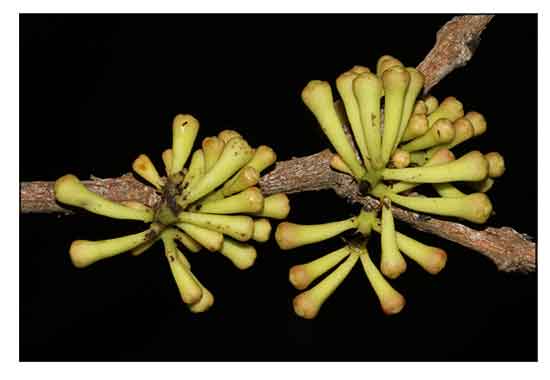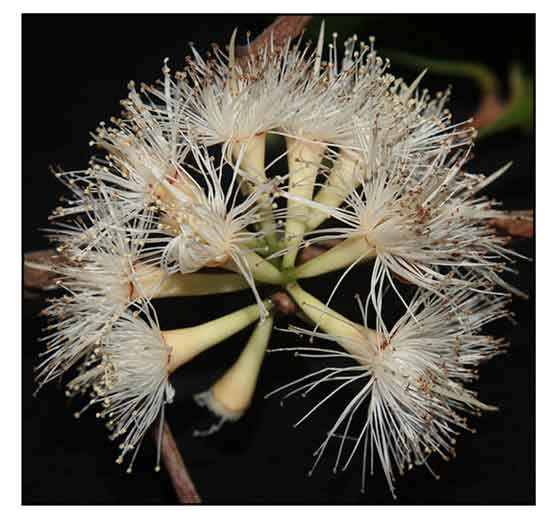
Family • Myrtaceae
Trumpet eugenia
Syzygium claviflorum (Roxb.) Wall. ex Steud.
TRUMPET SATINASH
Bang hua pu tao
| Scientific names | Common names |
| Acmena claviflora (Roxb.) Walp. | Grey satinash (Engl.) |
| Acmena leptantha Walp. | Satinash (Engl.) |
| Acmena wightiana (Wall. ex Wight & Arn.) Walp. | Trumpet eugenia (Engl.) |
| Acmenosperma claviflorum (Roxb.) Kausel | Trumpet satinash (Engl.) |
| Clavimyrstus claviflora (Roxb.) Blume | Watergum (Engl.) |
| Eugenia clavata (Korth.) Merr. | |
| Eugenia claviflora Roxb. | |
| Eugenia claviflora var. excavata King | |
| Eugenia claviflora var. glandulosa King | |
| Eugenia claviflora var. leptantha (Walp.) King | |
| Eugenia claviflora var. maingayi (Duthie) King | |
| Eugenia fraseru Ridl. | |
| Eugenia leptalea Craib. | |
| Eugenia leptantha Wight | |
| Eugenia maingayi Duthie | |
| Eugenia rhododendrifolia Miq. | |
| Eugenia rhododendrifolia f. longifolia Miq. | |
| Eugenia ruminata Koord. & Valeton | |
| Eugenia viridifolia Elmer | |
| Eugenia wightiana (Wall. ex Wight & Arn.) Wight | |
| Jambosa borneensis Miq. | |
| Jambosa clavata Korth. | |
| Jambosa melanocarpa Miq. | |
| Syzygium baviense (Gagnep.) Merr. & L.M.Perry | |
| Syzygium clavatum (Korth.) Merr. & L.M.Perry | |
| Syzygium claviflorum (Roxb.) Wall. ex Steud. | |
| Syzygium claviflorum var. excavatum (King) I.M.Turner | |
| Syzygium claviflorum var. glandulosum (King) Chantar. & J.Parn. | |
| Syzygium claviflorum var. maingayi (Duthie) Chantar. & J.Parn. | |
| Syzygium fraseri (Ridl.) Masam. | |
| Syzygium leptanthum (Walp.) Nied. | |
| Syzygium rhododendrifolium (Miq.) Masam. | |
| Syzygium ruminaturm (Koord. & Valeton) Amshoff | |
| Syzygium viridifolium (Elmer) Merr. & L.M.Perry | |
| Syzygium wightianum Wall. ex Wight & Arn. | |
| Syzygium claviflorum is an accepted species. KEW: Plants of the World Online | |
| Other vernacular names |
| AUSTRALIA: Grey satinash. |
| BORNEO: Gelam, Lenceh, Obah, Ubah. |
| CHINESE: Bang hua pu tao. |
| xxxx: xxxx, Teriba . |
| KHMER: Pri:ng ach kanndaor, Pri:ng ach' romeang. |
| SIKKIM: Harejamun. |
| VIETNAMESE: Tram trang. |
| OTHERS: Bangkoh, Muyu. |
April 2024
![]()
 |
| PHOTOS / ILLUSTRATIONS |
| IMAGE SOURCE: Syzygium claviflorum / © Cerlin Ng / Some rights reserved / CC BY-SA 2.0 DEED / Image modified / Click on image or link to go to source page / flickr |
| OTHER IMAGE SOURCE: /Gliricidia sepium (Jacq.) Kunth ex Walp. - quickstick GLSE2 / Steve Hurst @ USDA-NRCS PLANTS Database / USDA |
| https://images.ala.org.au//image/33b35519-6a1a-427b-afad-67b991a690f9 |
| IMAGE SOURCE: Hedyotis costata / Subject Database of China Plant <http://www.naturemuseum.net/album/ShowPhoto.aspx?photoid=2671c974-77ca-44f9-b304-0f16660a06f7> Helixcn |
| OTHER IMAGE SOURCE: /Gliricidia sepium (Jacq.) Kunth ex Walp. - quickstick GLSE2 / Steve Hurst @ USDA-NRCS PLANTS Database / USDA |
| OTHER IMAGE SOURCE: / File:Fruit of Syzygium samarangense / Wax apple / Plate from book / Flora de Filipinas / Francisco Manuel Blanco (OSA) / Public Domain / Wikimedia Commons |
| IMAGE SOURCE: / Photos (2) / Pterocaulon redolens (Willd.) F.-Vill. / © Collected by www.plant.ac.cn / ZHIWUTONG / CLICK ON IMAGE TO GO TO SOURCE PAGE |
| IMAGE SOURCE: / Line drawing / Pterocaulon redolens (Willd.) F.-Vill. / © Collected by www.plant.ac.cn / ZHIWUTONG / CLICK ON IMAGE TO GO TO SOURCE PAGE |
| IMAGE SOURCE:Phyllantaceae : Flueggea flexuosa / Leaf / Copyright © 2018 by P B Pelser & J F Barcelona (contact: [email protected]) [ref. DOL131909] / Non-Commercial Use / Image modified / Click on image or link to go to source page / Phytoimages.siu.edu |
| OTHER IMAGE SOURCE: / Flower close-up / dracobotanicus -- Wayne Dumbleton / Creative Commons Attribution / flickr / Click on graphic to see original image / flickr |
| OTHER IMAGE SOURCE: Mexican tea / Dysphania ambrosioides / © J Richard Abbott / Some rights reserved / NC BY-NC / Click on image or link to go to source page / iNaturalist |
| OTHER IMAGE SOURCE: / Illustration / Cissampelos pareira L. [5809-247450-161657] / Indian medicinal plants, vol. 1: t. 42 / PlantIllustrations.org |
| flickr |
| iNaturalistUK |
| IMAGE SOURCE: Erythrina fusca (Ngatae fisi) / Tau'olunga / CC BY-SA 3.0 / Click on image or link to go to source page / Wikipedia |
| Pacific Island Ecosystems at Risk (PIER) |
| Photos ©Godofredo Stuart / StuartXchange |
| Content © Godofredo Stuart / StuartXchange |
| Content / Photos © Godofredo Stuart / StuartXchange |
| Photos © Godofredo Stuart / StuartXchange |
Additional
Sources and Suggested Readings |
• |
DOI: It is not uncommon for links on studies/sources to change. Copying and pasting the information on the search window or using the DOI (if available) will often redirect to the new link page. (Citing and Using a (DOI) Digital Object Identifier) |
| List of Understudied Philippine Medicinal Plants |
| New plant names needed The compilation now numbers over 1,300 medicinal plants. While I believe there are hundreds more that can be added to the collection, they are becoming more difficult to find. If you have a plant to suggest for inclusion, native or introduced, please email the info: scientific name (most helpful), local plant name (if known), any known folkloric medicinal use, and, if possible, a photo. Your help will be greatly appreciated. |
• |
 |



